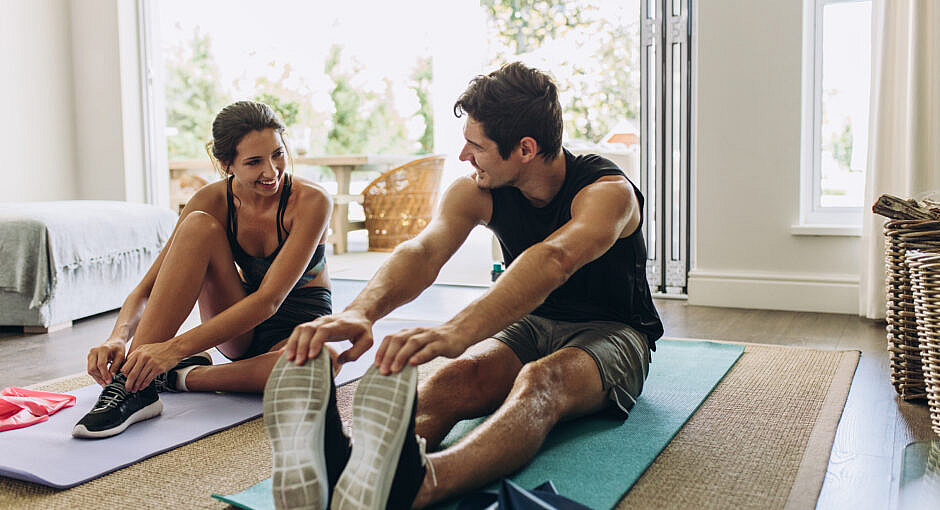In this article I’ll discuss 4 types of exercise, their benefits and give you information that will help you choose an exercise routine that’s right for you.
Let’s get started.
Our body needs 4 types of exercise, they are:
- Cardio or Aerobic Exercises
- Strength Exercises
- Flexibility or Stretching Exercises
- Balance Exercises
Each provides its own unique set of benefits. Let’s go over each.
Cardio Exercises
Cardio exercises increase your breathing and heart rate and are the main component of overall fitness programs. They keep the circulatory system and lungs healthy, can stave off diabetes and heart disease and help you build up endurance. Some common cardio exercises are:
- Brisk walking
- Jogging or running
- Marching in place
- Climbing stairs
- Step aerobics
- Swimming laps
- Riding a bicycle
- Dancing
Strength Exercises
Strength training is important for increased muscle mass and bone density. It helps you lose weight by increasing your metabolism. Muscle strength makes everyday activities easier and lowers your risk for injury. Examples of strength training include:
- Lifting free weights
- Using weight machines at a gym
- Using resistance bands
- Push-ups
- Pull-ups
- Ab crunches
- Leg squats
Flexibility Exercises
Flexibility exercises stretch your muscles and may improve your range of motion at your joints. There are two types of flexibility exercises: static stretching, in which you stretch a muscle without moving, and dynamic stretching, which combines stretching with movements. Examples of flexibility exercises are:
- Arm circles
- Arm swings
- Ankle stretch
- Neck stretch
- Back stretch
- Stretching routines using various parts of your body
- *Yoga
*My advice in using yoga is to avoid the mental, spiritual aspects of it and simply implement the physical exercises.
Balance Exercises
Balancing exercises are important because they prevent falls, they reduce the risk of lower-extremity injuries, such as knee and ankle injuries. They improve proprioception (the ability to know where you are in space).
- Heel-to-toe walking
- Standing on one foot
- Back leg raises using a chair for balance
- Using a balance board or stability ball
- Shifting your weight from side to side
- Practicing tai chi, yoga or pilates
Steps to Creating an Exercise Routine You Can Stick With
1. Pick a primary exercise type
Of the 4 exercise types, which one appeals to you the most?
Is it hard to catch your breath as you walk up stairs? Consider making Cardio exercises your primary choice.
Do you need help lifting things? Consider making Strength exercises your primary choice.
Are stiff? Does your back or neck hurt when you get up in the morning? Consider making Flexibility exercises your primary choice.
Are you older and afraid of falling down? Consider making Balancing exercises your primary choice.
2. Pick a secondary exercise type.
After you’ve picked your primary exercise type, pick a secondary exercise type.
The secondary exercise choice supplements your primary choice. The primary exercise addresses the main concern you have about your health. The secondary exercise adds another dimension to your health goals. Use it every other day to your primary routine.
3. Determine risk for heart attack.
For safety reasons, we want to see how fast your body can recover from exercise.
We can do this through a 1 minute test. Watch the video below.
In summary:
- Record your rest pulse rate
- Preform high intensity exercise for 1 minute (for example: running on a treadmill)
- Record peak pulse rate
- After 1 minute of rest record the recovery pulse rate
- Subtract recovery pulse rate from the peak pulse rate
Score Yourself
If the difference between the recovery rate and the peak pulse rate is:
- 12 or less— You are at risk of a heart attack
- Between 13-20— You have a moderate risk of a heart attack
- Between 21-40— You are good, no risk of a heart attack
4. Pick exercises within your primary and secondary exercise types based on your recovery rate score.
- If your recovery rate is 12 or below you would choose LOW intensity exercises within your exercise type(s) of choice.
- If your recovery rate is between 13-20 you would choose MODERATE intensity exercises within your exercise type(s) of choice.
- If your recovery rate is between 21-40 you would choose HIGH intensity exercises within your exercise type(s) of choice.
Where do you find the exercises?
You can search for exercise types with varying intensity levels on Fitness Blender’s website or their YouTube channel.
5. How much time should you spend exercising?
Low intensity exercise routines require:
- 30 minutes a day
- Can be broken down into (3) 10 minute sessions
- Just 2-3 days a week (even once a week if you are severely out of shape)
Moderate intensity exercise routines require:
- 30 minutes a day
- Can be broken down into (3) 10 minute sessions
- 5 days a week
High intensity exercise routines require:
- 15 minutes a day
- 5 days a week
If you are in good health and want to reduce your exercise time, you can do so by implementing High Intensity Interval Training or HIIT.
What is HIIT or High Intensity Interval Training?
HIIT involves short bursts of intense exercise alternated with low-intensity recovery periods.
Here is an example of High Intensity Interval Training.
Some HIIT programs can reduce your training time to as little as 2 1/2 minutes a day!
Conclusion
Physical health is the successful combination of 2 key factors: diet and exercise. Each contributes to the other.
An optimal diet provides the nutrients your body needs. An optimal exercise routine allows your body to absorb the nutrients of your diet by keeping its systems operating properly.
By following the guidelines in this article and those found under the diet category, you’ll be on your way to finding a life that works.


